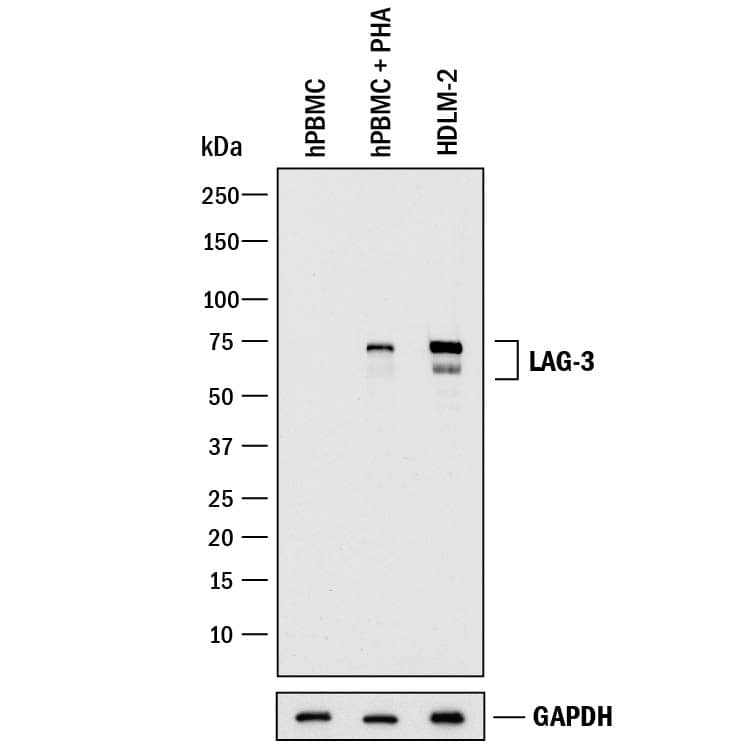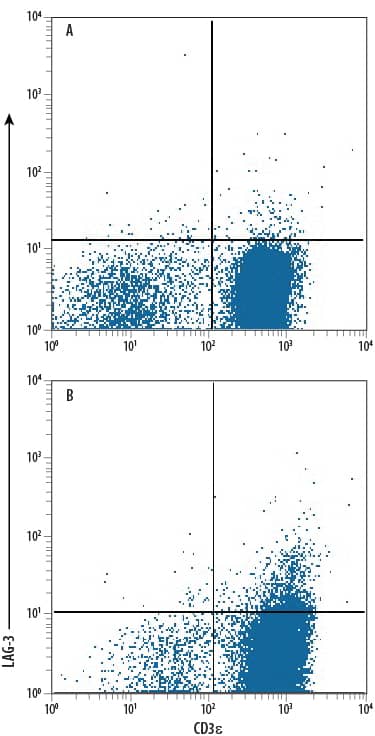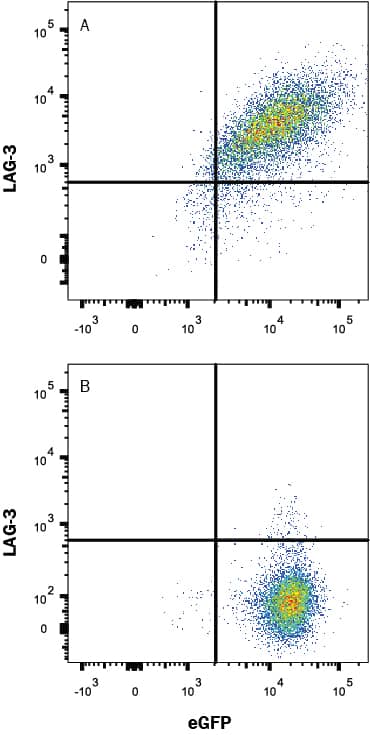Human LAG-3 Antibody
R&D Systems, part of Bio-Techne | Catalog # MAB23193


Key Product Details
Validated by
Species Reactivity
Validated:
Cited:
Applications
Validated:
Cited:
Label
Antibody Source
Product Specifications
Immunogen
Leu23-Leu450
Accession # P18627
Specificity
Clonality
Host
Isotype
Scientific Data Images for Human LAG-3 Antibody
Detection of Human LAG‑3 by Western Blot.
Western blot shows lysates of human peripheral blood mononuclear cells (PBMC) untreated or treated (+) with 1 ug/mL PHA for 5 days and HDLM-2 human Hodgkin's lymphoma cell line . PVDF membrane was probed with 2 µg/mL of Mouse Anti-Human LAG-3 Monoclonal Antibody (Catalog # MAB23193) followed by HRP-conjugated Anti-Mouse IgG Secondary Antibody (Catalog # HAF018). Specific bands were detected for LAG-3 at approximately 60-75 kDa (as indicated). GAPDH (Catalog # MAB5718) is shown as a loading control. This experiment was conducted under reducing conditions and using Immunoblot Buffer Group 1.Detection of LAG‑3 in Human PBMCs by Flow Cytometry.
Human peripheral blood mononuclear cells (PBMCs) were either untreated (top panel) or treated with with 5 µg/mL PHA (bottom panel) for 5 days. PBMCs were stained with Mouse Anti-Human LAG-3 Monoclonal Antibody (Catalog # MAB23193) followed by Allophycocyanin-conjugated Anti-Mouse IgG Secondary Antibody (Catalog # F0101B) and Mouse Anti-Human CD3e APC-conjugated Monoclonal Antibody (Catalog # FAB100A). Quadrant markers were set based on isotype control antibody staining (Catalog # MAB002) (data not shown). View our protocol for Staining Membrane-associated Proteins.Detection of LAG-3 in HEK293 Human Cell Line Transfected with Human LAG-3 and eGFP by Flow Cytometry.
HEK293 human embryonic kidney cell line transfected with either (A) human LAG-3 or (B) irrelevant transfectants and eGFP was stained with Mouse Anti-Human LAG-3 Monoclonal Antibody (Catalog # MAB23193) followed by APC-conjugated Anti-Mouse IgG Secondary Antibody (Catalog # F0101B) . Quadrant markers were set based on control antibody staining (Catalog # MAB002, data not shown). View our protocol for Staining Membrane-associated Proteins.Applications for Human LAG-3 Antibody
CyTOF-reported
Flow Cytometry
Sample: Human peripheral blood mononuclear cells (PBMCs) treated with PHA and HEK293 Human Cell Line Transfected with Human LAG-3 and eGFP
Western Blot
Sample: Human peripheral blood mononuclear cells (PBMC) treated with PHA and HDLM‑2 human Hodgkin's lymphoma cell line
Formulation, Preparation, and Storage
Purification
Reconstitution
Formulation
Shipping
Stability & Storage
- 12 months from date of receipt, -20 to -70 °C as supplied.
- 1 month, 2 to 8 °C under sterile conditions after reconstitution.
- 6 months, -20 to -70 °C under sterile conditions after reconstitution.
Background: LAG-3
LAG-3 is an activation-induced molecule, expressed on activated T cells and NK cells, but not on resting T cells. Studies using LAG-3 -/- mice have shown significant delay of T cell apoptosis following antigen stimulation and increased size of memory T cells pool following infection (3, 4). It also has been reported that anti-LAG-3 antibodies up-regulate T cell activation by blocking interaction of LAG-3 and MHC class II. The study has demonstrated that LAG-3 is selectively expressed on activated CD4+CD25+ TReg cells and plays a role in their suppressive activity (5). This evidence indicated, unlike the interaction of CD4 with MHC class II that plays a positive role in T cell activation, LAG-3 binds to MHC class II and negatively regulates T cell activation through LAG-3 signaling. On the other hand, studies have shown that binding of LAG-3 to MHC class II molecules on antigen presenting cells induce maturation of dendritic cells and cytokine secretion by monocytes through MHC class II signal transduction (6). Taken together, LAG-3 may have two major functions, it negatively regulates T cells activation through LAG-3 signaling and stimulates antigen presenting cells which express MHC class II.
References
- Triebel, F. et al. (1990) J. Exp. Med. 171:1393.
- Baixeras, E. et al. (1992) J. Exp. Med 176:327.
- Workman, C.J. and D.A. Vignali (2003) Eur. J. Immunol. 33:970.
- Workman, C.J. et al. (2004) J. Immunol. 172:5450.
- Huang, C.T. et al. (2004) Immunity 21:503.
- Andreae, S. et al. (2003) Blood 102:2130.
Long Name
Alternate Names
Gene Symbol
UniProt
Additional LAG-3 Products
Product Documents for Human LAG-3 Antibody
Product Specific Notices for Human LAG-3 Antibody
For research use only

